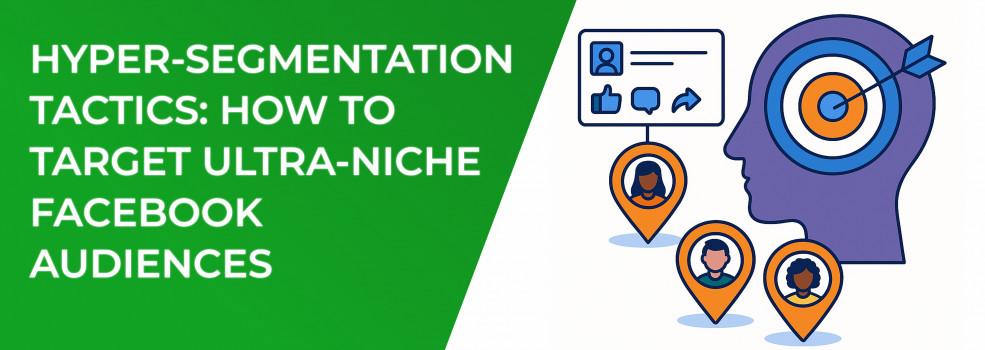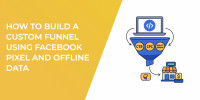Scrolling through today’s feed feels like wandering a bazaar of untargeted noise. Users barely notice bland promotions, and advertisers watch budgets evaporate. The antidote is hyper-segmentation — the art of speaking to the smallest group of people who are most likely to care. In this guide, you’ll discover how to build razor-sharp segments, choose the best Facebook ad targeting options, and craft creative that feels hand-delivered. Along the way you’ll encounter essential phrases such as Facebook ad targeting strategy and Facebook ads audience so you can quickly spot the concepts that matter most.
1. Map the Four Rings of Intent
Start by sketching four concentric circles on a notepad. Each ring represents a different slice of intent inside Facebook Audience Insights:
-
Core customers (warm audience Facebook ads)
These are your email subscribers, previous buyers, and site visitors. Build custom audiences from your CRM or pixel events and keep them evergreen. -
High-value lookalike audiences
Generate a 1–2% lookalike from your top-LTV buyers. Because Meta’s algorithm optimizes for value, these prospects often convert even on cold traffic. -
Interest and behavior blends
Mix Facebook interest targeting keywords (for example, “Trail Running Shoes”) with transactional behaviors (“Online Shoppers”) to create micro audience targeting pockets that punch above their weight. -
Micro-geo and event clusters
Activate geofencing with Facebook around trade-show venues, pop-up shops, or competitor storefronts. A one-mile radius often outperforms city-wide targeting.
Plotting every campaign on this diagram reveals where money leaks and where real scale lives.
A quick primer on defining personas is always helpful — see How to Define a Target Audience for Marketing: a Step-by-Step Guide if you need a refresher before mapping your rings.
2. Match Objectives to Meta’s Toolkit
Many advertisers jump straight into Ads Manager and toggle settings at random. Pause and ask, “Which objective truly serves my funnel stage?” The table below pairs three common goals with the features proven to work best.
If you’re still unsure which goal to pick, Meta Ad Campaign Objectives Explained: How to Choose the Right One will walk you through each option with real-world examples.
Automation excels only when your conversion signal is clean. If your pixel fires inconsistently, rely on detailed interests until the data pipeline is solid. After building a campaign, jot a short debrief note — “Using table settings based on Facebook ad targeting tips lowered CPC by 22%.” Small notes compound into big wins.
3. Sculpt Ultra-Niche Segments Like a Pro
Ads Manager is less “paint by numbers” and more “carve a statue.” Remove excess until the perfect form appears, then tweak gently as data rolls in.
-
Stack multiple AND filters, for example, “Plant-Based Diet” AND “Subscriptions” AND Age 24–35.
-
Exclude bargain hunters if you sell premium gear to protect margin.
-
Run dynamic store-locator ads so each promo shows the nearest address automatically.
-
Cap remarketing frequency at four weekly impressions to sidestep fatigue.
If delivery stalls under 1,000 impressions after 48 hours, loosen one qualifier at a time. That habit embodies the spirit of Facebook ad targeting keywords mastery.
Persistent “ad set may get zero” warnings are covered in detail in Why You See “Ad Set May Get Zero” on Facebook — and How to Fix It.
4. Write Copy That Feels Hand-Written
A perfect segment is worthless without matching creative. Before producing assets, draft a one-sentence promise to each niche:
-
“Austin freelance developers” → taco-truck illustration; headline: “Land clients who pay on time.”
-
“New moms, 0–12 months” → carousel of stroller hacks; CTA: “Claim 15% off your first sleep-training class.”
Creative must mirror each micro-segment’s language, visuals, and pain points.
Sprinkle naturally flowing phrases such as Facebook ads advice, Facebook ads hacks, and targeted advertising on social media into body text and image alt tags. They satisfy SEO intent while still sounding human.
5. Test, Learn, Repeat
Testing is the gym membership of paid social — everyone mentions it, few commit. Adopt this lightweight routine:
-
Launch one variable per ad set at 20 USD per day for three days.
-
Pause any set with CPC above target by Day 4.
-
Duplicate winners into a 2–5% lookalike or loosened geo ring.
-
Watch cost per result; if it rises while frequency spikes, your creative is exhausted.
When frequency creeps up, consult Ad Fatigue on Facebook: How to Spot It Early and Fix It Fast for refresh tactics.
Close each sprint with a verdict — keep, kill, or retest. This cadence forms the backbone of every durable Facebook ad targeting strategy.
6. Stay Compliant, Stay Safe
Hyper-segmentation can feel creepy if mishandled. Double-check Meta’s policies on housing, employment, and credit. Avoid language implying personal attributes, and refresh creatives every 7–10 days to maintain relevance.
For a full checklist of do’s and don’ts, bookmark How to Avoid Ad Rejection on Facebook: Meta Ad Policies Explained.
Conclusion: Win the Auction by Owning Intent
The news-feed auction doesn’t reward the loudest brand; it rewards the most relevant. By mastering Facebook ad interest targeting, tightening segments, and echoing each audience’s language, you’ll trade bloated impressions for qualified clicks, and you’ll do it at a fraction of the usual CPM.
Run fewer, sharper campaigns. Measure relentlessly. Each time you open Ads Manager, remember that the smallest viable audience often hides the biggest upside.

